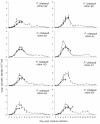Experimental manipulation of immune-mediated disease and its fitness costs for rodent malaria parasites
- PMID: 18447949
- PMCID: PMC2391164
- DOI: 10.1186/1471-2148-8-128
Experimental manipulation of immune-mediated disease and its fitness costs for rodent malaria parasites
Abstract
Background: Explaining parasite virulence (harm to the host) represents a major challenge for evolutionary and biomedical scientists alike. Most theoretical models of virulence evolution assume that virulence arises as a direct consequence of host exploitation, the process whereby parasites convert host resources into transmission opportunities. However, infection-induced disease can be immune-mediated (immunopathology). Little is known about how immunopathology affects parasite fitness, or how it will affect the evolution of parasite virulence. Here we studied the effects of immunopathology on infection-induced host mortality rate and lifetime transmission potential - key components of parasite fitness - using the rodent malaria model, Plasmodium chabaudi chabaudi.
Results: Neutralizing interleukin [IL]-10, an important regulator of inflammation, allowed us to experimentally increase the proportion of virulence due to immunopathology for eight parasite clones. In vivo blockade of the IL-10 receptor (IL-10R) with a neutralizing antibody resulted in a shorter time to death that was independent of parasite density and was particularly marked for normally avirulent clones. This suggests that IL-10 induction may provide a pathway to avirulence for P. c. chabaudi. Despite the increased investment in transmission-stage parasites observed for some clones in response to IL-10R blockade, experimental enhancement of immunopathology incurred a uniform fitness cost to all parasite clones by reducing lifetime transmission potential.
Conclusion: This is the first experimental study to demonstrate that infection-induced immunopathology and parasite genetic variability may together have the potential to shape virulence evolution. In accord with recent theory, the data show that some forms of immunopathology may select for parasites that make hosts less sick.
Figures




Similar articles
-
Host-parasite interactions for virulence and resistance in a malaria model system.J Evol Biol. 2006 Sep;19(5):1620-30. doi: 10.1111/j.1420-9101.2006.01116.x. J Evol Biol. 2006. PMID: 16910991
-
Virulence in rodent malaria: host genotype by parasite genotype interactions.Infect Genet Evol. 2002 Jul;1(4):287-96. doi: 10.1016/s1567-1348(02)00039-4. Infect Genet Evol. 2002. PMID: 12798007
-
The effects of host immunity on virulence-transmissibility relationships in the rodent malaria parasite Plasmodium chabaudi.Parasitology. 2003 Feb;126(Pt 2):103-12. doi: 10.1017/s003118200200272x. Parasitology. 2003. PMID: 12636347
-
Virulence evolution in response to vaccination: the case of malaria.Vaccine. 2008 Jul 18;26 Suppl 3(48-5):C42-52. doi: 10.1016/j.vaccine.2008.04.012. Vaccine. 2008. PMID: 18773536 Free PMC article. Review.
-
Virulence in malaria: an evolutionary viewpoint.Philos Trans R Soc Lond B Biol Sci. 2004 Jun 29;359(1446):965-86. doi: 10.1098/rstb.2003.1414. Philos Trans R Soc Lond B Biol Sci. 2004. PMID: 15306410 Free PMC article. Review.
Cited by
-
Plasmodium relictum infection and MHC diversity in the house sparrow (Passer domesticus).Proc Biol Sci. 2011 Apr 22;278(1709):1264-72. doi: 10.1098/rspb.2010.1968. Epub 2010 Oct 13. Proc Biol Sci. 2011. PMID: 20943698 Free PMC article.
-
Disrupting immune regulation incurs transient costs in male reproductive function.PLoS One. 2014 Jan 6;9(1):e84606. doi: 10.1371/journal.pone.0084606. eCollection 2014. PLoS One. 2014. PMID: 24400103 Free PMC article.
-
Differing House Finch Cytokine Expression Responses to Original and Evolved Isolates of Mycoplasma gallisepticum.Front Immunol. 2018 Jan 22;9:13. doi: 10.3389/fimmu.2018.00013. eCollection 2018. Front Immunol. 2018. PMID: 29403495 Free PMC article.
-
Plasmodium chabaudi AS induces pregnancy loss in association with systemic pro-inflammatory immune responses in A/J and C57BL/6 mice.Parasite Immunol. 2012 Apr;34(4):224-35. doi: 10.1111/j.1365-3024.2012.01355.x. Parasite Immunol. 2012. PMID: 22251385 Free PMC article.
-
A comprehensive evaluation of rodent malaria parasite genomes and gene expression.BMC Biol. 2014 Oct 30;12:86. doi: 10.1186/s12915-014-0086-0. BMC Biol. 2014. PMID: 25359557 Free PMC article.
References
-
- Dieckmann U, Metz JAJ, Sabelis MW, Sigmund K. Adaptive Dynamics of Infectious Diseases: In Pursuit of Virulence Management. First. Cambridge University Press; 2002.
-
- Anderson RM, May RM. Coevolution of hosts and parasites. Parasitology. 1982;85(Pt 2):411–426. - PubMed
-
- Ewald PW. Host-parasite relations, vectors and the evolution of disease severity. Annual Review of Ecology and Systematics. 1983;14:465–485. doi: 10.1146/annurev.es.14.110183.002341. - DOI
Publication types
MeSH terms
Substances
Grants and funding
LinkOut - more resources
Full Text Sources
Medical

